Assessing the Horizontal Homogeneity of the Atmospheric Boundary Layer (HHABL) Profile Using Different CFD Software
Abstract
1. Introduction
2. Methodology
- The transport equations for the turbulent kinetic energy and dissipation rate for the three different software and the differences between them.
- The differences—if any—between the various constants.
- The boundary conditions necessary to achieve homogeneity in the different software, e.g., (i) ground boundary conditions/wall functions, (ii) boundary conditions, and (iii) outlet boundary conditions. The inlet conditions were the same in all software and in all cases tested.
- The numerical solvers and meshing options for each case.
2.1. Theoretical Background
Governing Equations
- (a)
- RANS Equations
- (b)
- Eddy Viscosity Models
- (c)
- Transport equations for the turbulent kinetic Energy k and dissipation rate
2.2. Computational Aspects
2.2.1. Computational Domain and Meshing
- (i)
- Fluent and CFX meshing options
- (ii)
- Siemens STAR-CCM+ meshing options
2.2.2. Inlet Boundary Conditions
2.2.3. The Wall Boundary Conditions
- (i)
- Fluent and CFX
- (ii)
- Siemens STAR-CCM+
2.3. Computational Schemes
- (a)
- In ANSYS Fluent
- (b)
- in ANSYS CFX
- (c)
- in Siemens STAR-CCM+
3. Computational Results
3.1. Case 1
3.2. Case 2
Effect of the Ground Roughness Height Zs in ANSYS CFX
3.3. Case 3
4. Discussion
- Case 1 shows the largest MAPEs amongst the software, with Fluent and STAR-CCM+ exhibiting acceptable HHABL for the velocity and TDR profiles, whilst CFX exhibits the largest MAPEs from the inlet profile, averaging a value over all locations of ~5% for the velocity, with an SD of near 12%, whilst, for the TDR profile, the location-averaged MAPEs are close to 15%, with a corresponding SD of 25% (Table 5). The lowest TDR variations are observed with Ansys Fluent, with a location-averaged MAPE value of 5.6% and a corresponding SD of 4.5%, whilst STAR-CCM+ exhibits slightly higher values of 7.9% and 9.8% (SD values). It is noted that STAR-CCM+ software implements a two-layer k–ε realizable model, where the TDR value in the layer near the wall is estimated using the Wolfstein expression, as opposed to the transport equation. In contrast, the CFX software results in the lowest TKE differences, with a location-averaged MAPE of 5.5% and the lowest SD of nearly 6%, whilst Fluent and STAR-CCM+ exhibit higher location-averaged MAPEs, nearing 12%, but lower corresponding SDs of 3.1% and 4.6%, respectively (Table 5). These higher variations in TKE may not be surprising, as the inlet TKE profile is an unrealistic, constant (with height) profile, although CFX seems to be able to preserve the TKE profile better than Fluent and STAR-CCM+.
- Case 2 exhibits a good HHABL profile for all three software. For Case 2, the best overall performance for the velocity profiles appears to be with the STAR-CCM+ software, where the location-averaged MAPEs are less than 0.5% and, also, have the lowest SDs (<1%). For the TDR profiles, STAR-CC+ results in the lowest location-averaged MAPE value of 4.22%, with a similar value by the Fluent software, but STAR-CCM+ appears to have a higher SD (7%), as opposed to the ~5% of SD using Fluent. The CFX software results in the slightly higher location-averaged value of the MAPE (5.95%) and the highest corresponding SD (10.1%) (Table 6). It is noted that STAR-CCM+ implements the blended wall function, and a higher resolution mesh is necessary (base cell size of 0.1 m), in combination with a relative velocity of −12 m/s and a roughness length of 0.03 m, as opposed to the roughness height Zs = 0.4 m in Fluent and Zs = 0.88 m in CFX. The differences in the TDR values between STAR-CCM+ and the other two software (ANSYS Fluent and ANSYS CFX) may be again due to the fact that, in STAR-CCM+, a two-layer k–ε realizable model was implemented, in which the TDR value in the layer near the wall was estimated using the Wolfstein expression, as opposed to the transport equation. Although the ANSYS CFX software did not perform as well as the other two software for the velocity and TDR profiles, it seemed to perform better than Fluent and STAR-CCM+ in relation to the TKE, exhibiting the lowest location-averaged values and SDs, as seen in Table 6.
- Case 3 shows the lowest MAPE values (Table 7), with STAR-CCM+ performing best in preserving the inlet velocity and TDR profiles, with the lowest average (over all locations) MAPE values being less than 0.25% for velocity and less than 2% for TDR, respectively, whilst the CFX software succeeds in preserving the TKE profiles, with the lowest average (over all locations) MAPEs less than 3%.
- STAR-CCM+ differs from the other two software in its implementation of the blended wall function approach and the estimation of the TDR near the wall using Equation (25), as opposed to the full transport equation (Equation (16)). Results for the TDR predictions from Table 5, Table 6 and Table 7 indicate that, for Case 1, STAR-CCM+ performed better than CFX but worse than Fluent. For Case 2, STAR-CCM+ resulted in the lowest MAPE values (for TDR), compared to Fluent and CFX, indicating perhaps that the blended function approach is a better approach. However, the corresponding SDs with STAR-CCM+ were higher than Fluent. For Case 3, STAR-CCM+ resulted in the lowest MAPE values for TDR and the lowest SDs. The improved simulation results using STAR-CCM+ for Case 3 may be attributed to the blended wall function approach and the two-layer k-e approach, with the implementation of the Wolfstein expression for the estimation of the near-wall TDR values
- The SDs estimated in all cases for all parameters and all three software are, in most cases, of the same order as the corresponding MAPE values, with Case 3 showing the lowest MAPE values, as well as the lowest SD values, as seen in Table 5, Table 6 and Table 7. The averaged MAPEs and averaged SDs (over all locations) for each parameter are also shown in Table 7, clearly indicating that the lowest values are obtained with Case 3. Highest variations in the averaged MAPEs occur for the TKE in all software, with values ranging from 2% to ~5%, whilst the corresponding SDs are close to 3% for all three software.
5. Conclusions
- The varying meshing options chosen in the different software, i.e., the prism-layer option given in STAR-CCM+, as opposed to the uniform/structured mesh in Fluent and CFX. It is noted that higher resolution meshes were considered in both Fluent and CFX but with no visible improvement in the HHABL profile, consistent with the findings of previous research.
- Slight variations in the expressions for the eddy viscosity models (Equations (5) and (8)).
- Slight variations in the wall boundary condition functions. As was discussed in Section 2.2.3, slightly different wall functions were implemented in the three software, with the standard wall function in Fluent, the scalable wall function in CFX, and the blended wall function in STAR-CCM+. Similar constants were used in the three functions; however, for example, the scalable wall function implemented in CFX may be a more suitable function than the standard wall function, as it overcomes the inconsistencies/inaccuracies near the wall when higher resolution meshes are used near the wall. STAR-CCM+ implemented the blended wall function, and, in combination with a high-resolution mesh (bases size of 0.1 m) and a relative velocity, it resulted in a good preservation of the profiles for both Cases 2 and 3. When using a structured, uniform mesh with a base cell size of 0.5 m, without a finer resolution near the wall, STAR-CCM+ did not perform as well as the other software.
- Slight differences in the turbulence model, as the realizable model was implemented in both the Fluent and STAR-CCM+ applications, whilst only the standard model was available in the CFX software.
- Further works will consider the implementation of the same three software, with the inclusion of a single obstacle within the domain, to assess again the possible differences between the three software for the estimation of turbulence quantities.
Author Contributions
Funding
Acknowledgments
Conflicts of Interest
References
- Blocken, B. Computational Fluid Dynamics for urban physics: Importance, scales, possibilities, limitations and ten tips and tricks towards accurate and reliable simulations. Build. Environ. 2015, 91, 219–245. [Google Scholar] [CrossRef]
- Lateb, M.; Meroney, R.; Yataghene, M.; Fellouah, H.; Saleh, F.; Boufadel, M. On the use of numerical modelling for near-field pollutant dispersion in urban environments—A review. Environ. Pollut. 2016, 208, 271–283. [Google Scholar] [CrossRef] [PubMed]
- Yan, B.; Li, Q.; He, Y.; Chan, P. RANS simulation of neutral atmospheric boundary layer flows over complex terrain by proper imposition of boundary conditions and modification on the k-ε model. Environ. Fluid Mech. 2016, 16, 1–23. [Google Scholar] [CrossRef]
- Chang, C.-Y.; Schmidt, J.; Dörenkämper, M.; Stoevesandt, B. A consistent steady state CFD simulation method for stratified atmospheric boundary layer flows. J. Wind Eng. Ind. Aerodyn. 2018, 172, 55–67. [Google Scholar] [CrossRef]
- Abohela, I.; Hamza, N.; Dudek, S. Effect of roof shape, wind direction, building height and urban configuration on the energy yield and positioning of roof mounted wind turbines. Renew. Energy 2013, 1106–1118. [Google Scholar] [CrossRef]
- van Hooff, T.; Blocken, B.; Tominaga, Y. On the accuracy of CFD simulations of cross-ventilation flows for a generic isolated building: Comparison of RANS, LES and experiments. Build. Environ. 2017, 114, 148–165. [Google Scholar] [CrossRef]
- Blocken, B.; Stathopoulos, T.; van Beeck, J.P.A.J. Pedestrian-level wind conditions around buildings: Review of wind-tunnel and CFD techniques and their accuracy for wind comfort assessment. Build. Environ. 2016, 100, 50–81. [Google Scholar] [CrossRef]
- Toparlar, Y.; Blocken, B.; Vos, P.; Van Heijst, G.; Janssen, W.; van Hooff, T.; Timmermans, H. CFD simulation and validation of urban microclimate: A case study for Bergpolder Zuid, Rotterdam. Build. Environ. 2015, 83, 79–90. [Google Scholar] [CrossRef]
- Guo, W.; Liu, X.; Yuan, X. Study on Natural Ventilation Design Optimization Based on CFD Simulation for Green Buildings. Procedia Eng. 2015, 121, 573–581. [Google Scholar] [CrossRef]
- Abohela, I. On the horizontal homogeneity of the Atmospheric Boundary Layer in CFD simulations. Appl. Math. Inf. Sci. 2018, 12, 825–829. [Google Scholar] [CrossRef]
- Hu, C.-H. Proposed Guidelines of Using CFD and the Validity of the CFD Models in the Numerical Simulations of Wind Environments around Buildings. Ph.D. Thesis, Heriot-Watt University, Edinburgh, UK, 2013. [Google Scholar]
- Hargreaves, D.M.; Wright, N.G. On the use of the k-[epsilon] model in commercial CFD software to model the neutral atmospheric boundary layer. J. Wind Eng. Ind. Aerodyn. 2007, 95, 355–369. [Google Scholar] [CrossRef]
- Cai, X.; Huo, Q.; Kang, L.; Song, Y. Equilibrium atmospheric boundary-layer flow: Computational fluid dynamics simulation with balanced forces. Bound. Layer Meteorol. 2014, 152, 349–366. [Google Scholar] [CrossRef]
- Aly, A.M. Atmospheric boundary-layer simulation for the built environment: Past, present and future. Build. Environ. 2014, 75, 206–221. [Google Scholar] [CrossRef]
- Richards, P.J.; Younis, B.A. Comments on “Prediction of the wind-generated pressure distribution around buildings” by E.H. Mathews. J. Wind Eng. Ind. Aerodyn. 1990, 34, 107–110. [Google Scholar] [CrossRef]
- O’Sullivan, J.; Archer, R.; Flay, R. Consistent boundary conditions for flows within the atmospheric boundary layer. J. Wind Eng. Ind. Aerodyn. 2011, 99, 65–77. [Google Scholar] [CrossRef]
- Mathews, E.H. Prediction of the wind-generated pressure distribution around buildings. J. Wind Eng. Ind. Aerodyn. 1987, 25, 219–228. [Google Scholar] [CrossRef]
- Zhang, C.X. Numerical prediction of turbulent recirculating flows with a k-e model. J. Wind Eng. Ind. Aerodyn. 1994, 51, 177–201. [Google Scholar] [CrossRef]
- Blocken, B.; Stathopoulos, T.; Carmeliet, J. CFD simulation of the atmospheric boundary layer: Wall function problems. Atmos. Environ. 2007, 41, 238–252. [Google Scholar] [CrossRef]
- Blocken, B.; Carmeliet, J.; Stathopoulos, T. CFD evaluation of wind speed conditions in passages between parallel buildings—Effect of wall-function roughness modifications for the atmospheric boundary layer flow. J. Wind Eng. Ind. Aerodyn. 2007, 95, 941–962. [Google Scholar] [CrossRef]
- Launder, B.E.; Spalding, D.B. The numerical computation of turbulent flows. Comput. Methods Appl. Mech. Eng. 1974, 3, 269–289. [Google Scholar] [CrossRef]
- Quinn, A.D.; Wilson, M.; Reynolds, A.M.; Couling, S.B.; Hoxey, R.P. Modelling the dispersion of aerial pollutants from agricultural buildings—An evaluation of computational fluid dynamics (CFD). Comput. Electron. Agric. 2001, 30, 219–235. [Google Scholar] [CrossRef]
- Riddle, A.; Carruthers, D.; Sharpe, A.; McHugh, C.; Stocker, J. Comparisons between FLUENT and ADMS for atmospheric dispersion modelling. Atmos. Environ. 2007, 38, 1029–1038. [Google Scholar] [CrossRef]
- Miles, S.; Westbury, P. Practical tools for wind engineering in the built environment. QNET-CFD Netw. Newsl. 2003, 2, 11–14. [Google Scholar]
- Franke, J.; Hirsch, C.; Jensen, A.G.; Krüs, H.W.; Schatzmann, M.; Westbury, P.S.; Miles, S.D.; Wisse, J.A.; Wright, N.G. Recommendations on the use of CFD in wind engineering. In Proceedings of the International Conference on Urban Wind Engineering and Building Aerodynamics, Sint-Genesius-Rode, Belgium, 5–7 May 2004. [Google Scholar]
- Franke, J.; Frank, W. Numerical simulation of the flow across an asymmetric street intersection. In Proceedings of the 4EACWE, Prague, Czech Republic, 11–15 July 2005. [Google Scholar]
- Blocken, B.; Carmeliet, J. The influence of the wind-blocking effect by a building on its wind-driven rain exposure. J. Wind Eng. Ind. Aerodyn. 2006, 94, 101–127. [Google Scholar] [CrossRef]
- Richards, P.; Norris, S. Appropriate boundary conditions for a pressure driven boundary layer. J. Wind Eng. Ind. Aerodyn. 2015, 142, 43–52. [Google Scholar] [CrossRef]
- Yang, Y.; Gu, M.; Chen, S.; Jin, X. New inflow boundary conditions for modelling the neutral equilibrium atmospheric boundary layer in computational wind engineering. J. Wind Eng. Ind. Aerodyn. 2009, 97, 88–95. [Google Scholar] [CrossRef]
- Commercial CFD ANSYS Fluent User Manual R2; Fluent R2; 2020. Available online: https://ansyshelp.ansys.com/account/secured?returnurl=/Views/Secured/prod_page.html?pn=Fluent&lang=en (accessed on 31 May 2020).
- Commercial CFD ANSYS CFX User Manual R2; CFX R2; 2020. Available online: https://ansyshelp.ansys.com/account/secured?returnurl=/Views/Secured/prod_page.html?pn=CFX&lang=en (accessed on 31 May 2020).
- Commercial Siemens STAR-CCM+ Software Manual. Available online: https://www.plm.automation.siemens.com/global/en/products/simcenter/STAR-CCM.html (accessed on 30 November 2019).
- Solari, G. Wind Science and Engineering. In Origins, Developments, Fundamentals and Advancements; Springer: Berlin/Heidelberg, Germany, 2019; ISBN 978-3-030-18814-6. [Google Scholar]
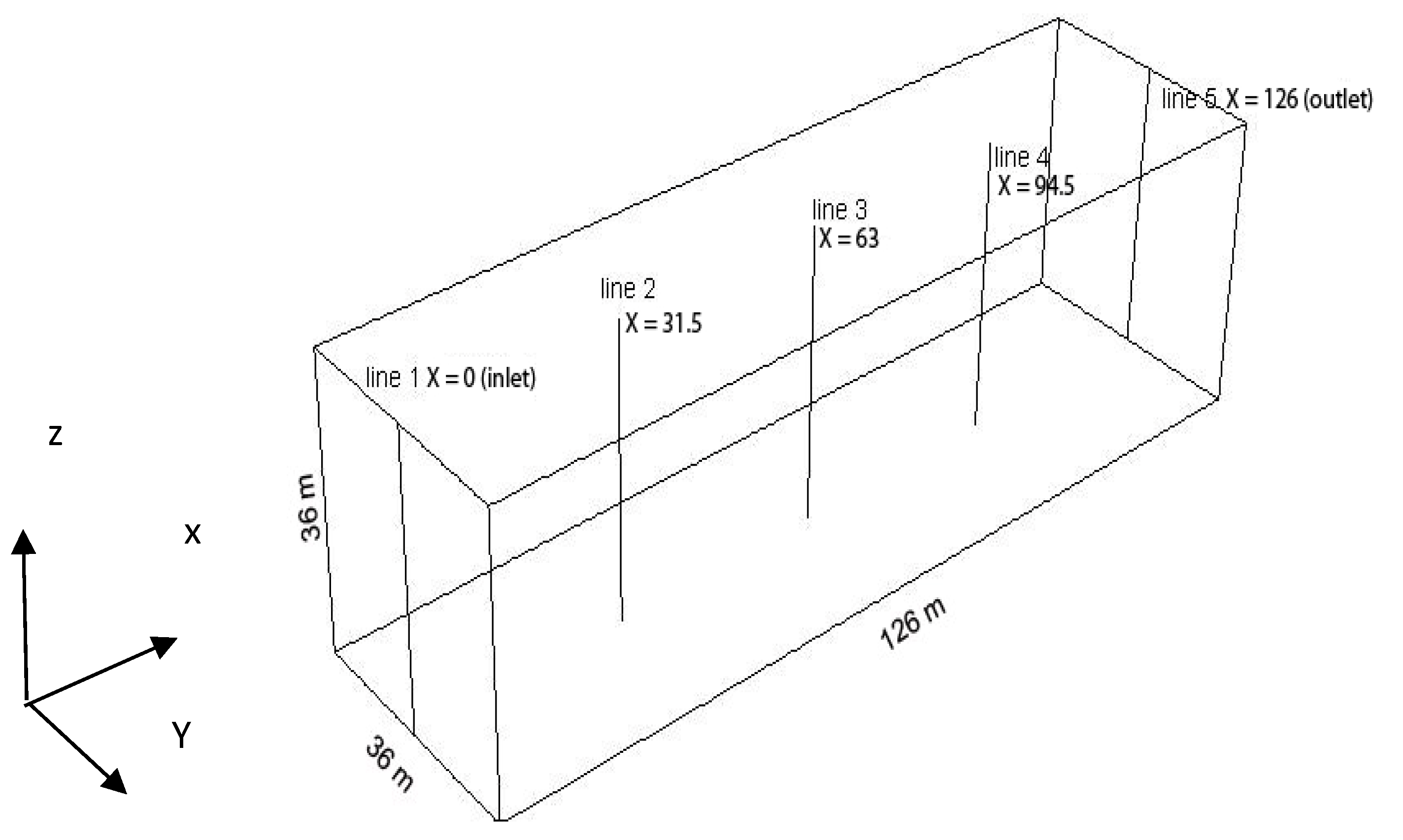






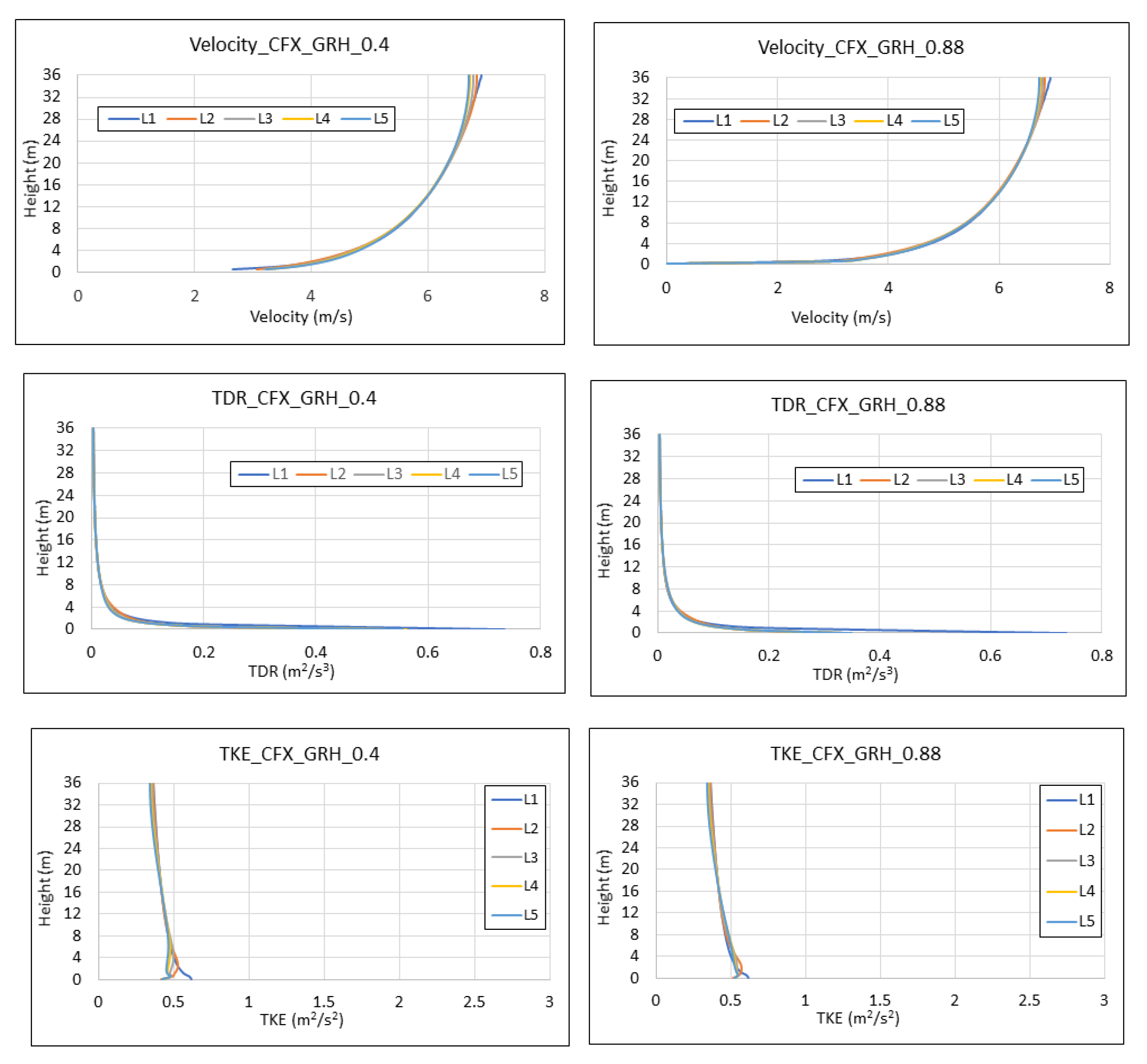

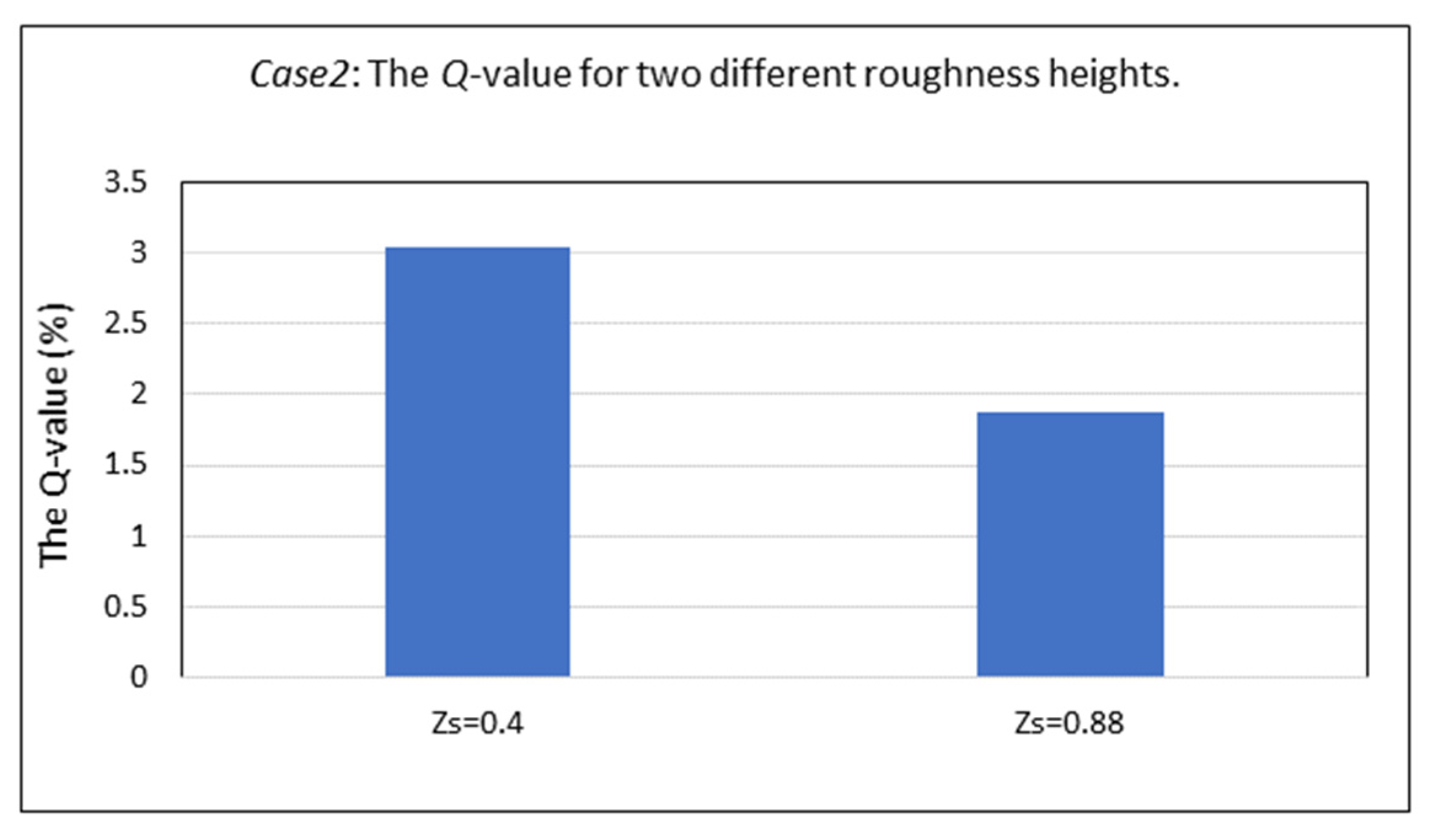
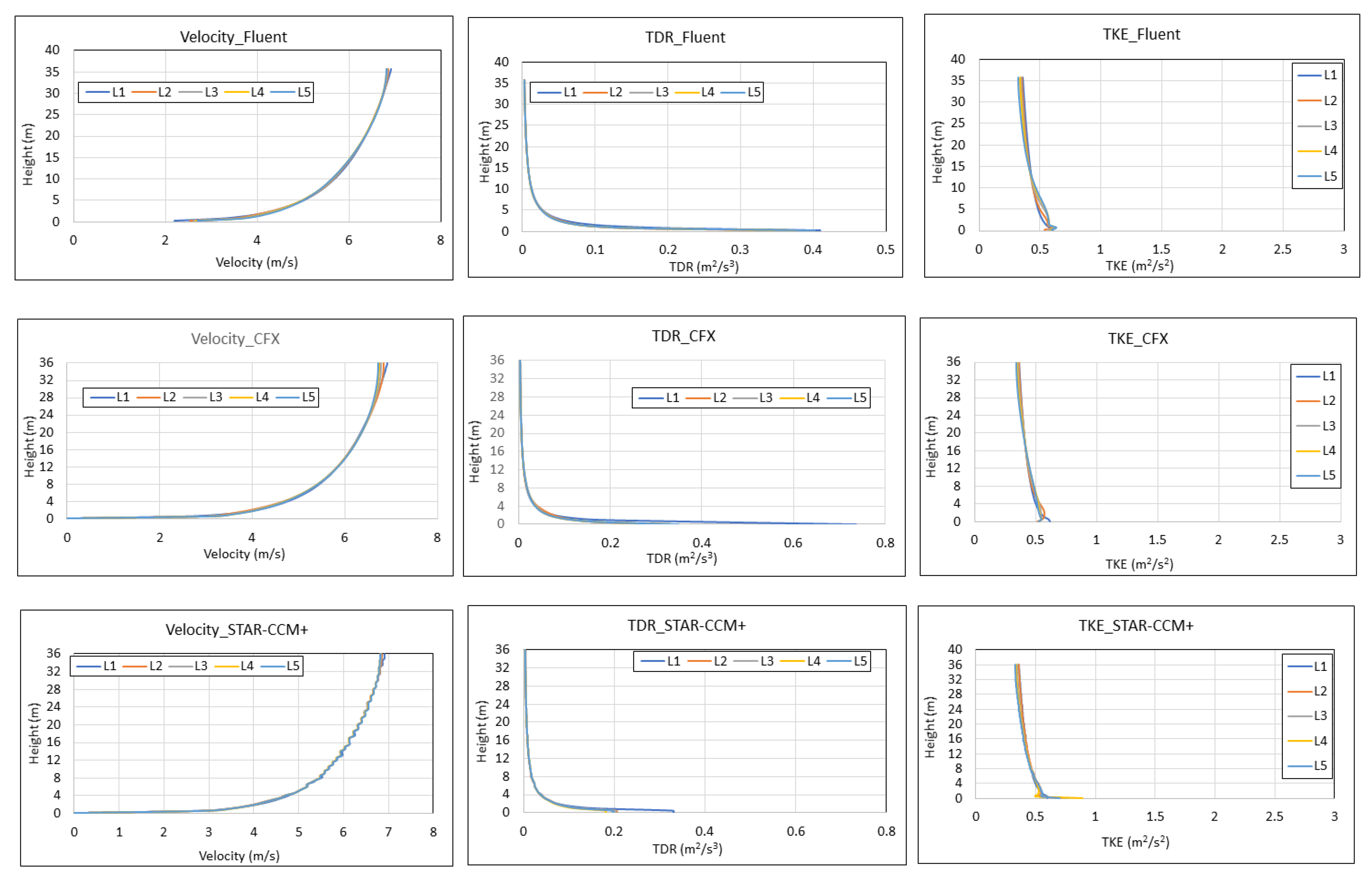



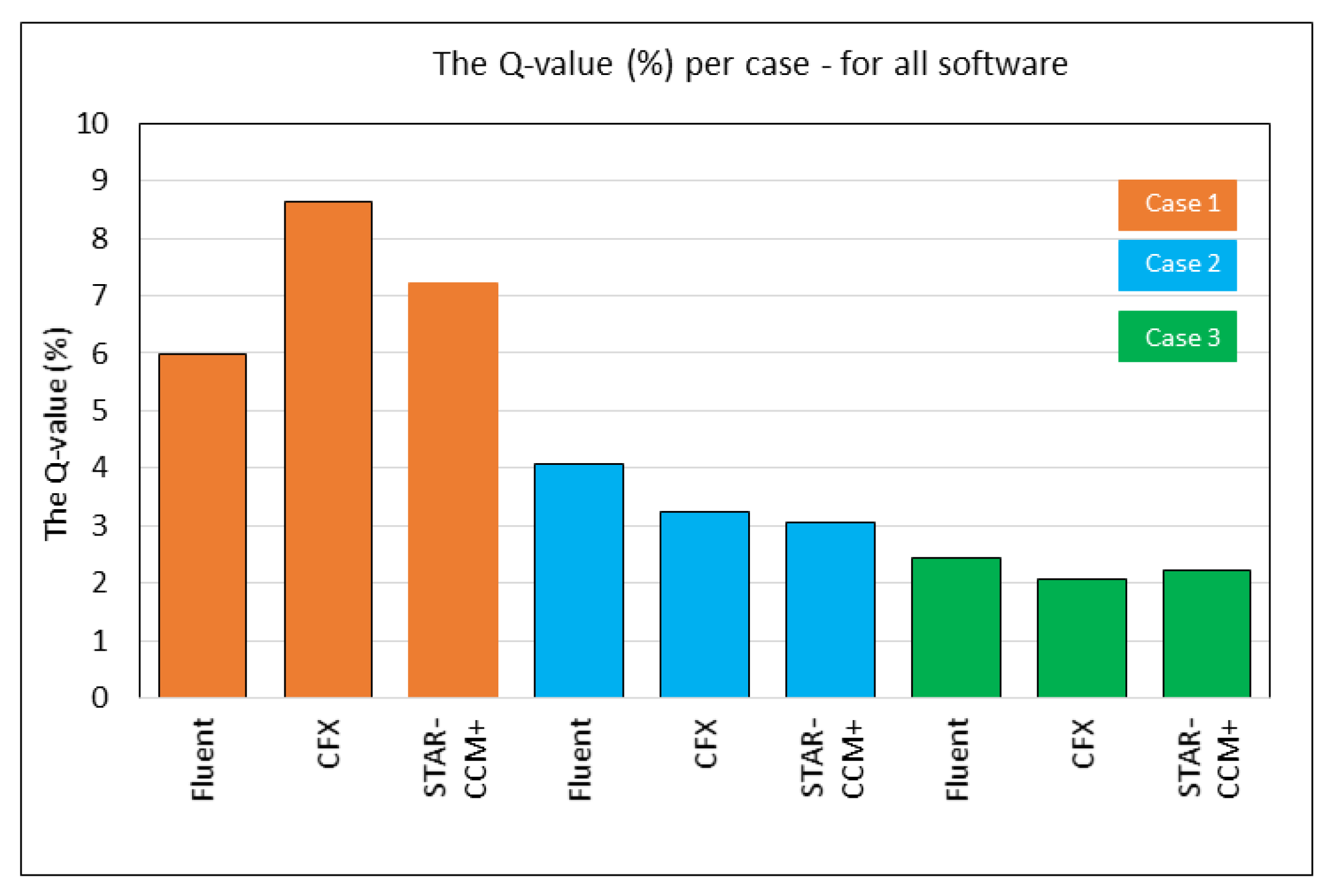
| Turbulence Model | Cases | Roughness Height (m) Zs | ||||||
|---|---|---|---|---|---|---|---|---|
| Fluent Realizable | 1, 2, 3 | 1 | 1.2 | 1.44 | Same as C2 = 1.9 | As per Equation (6) | 0.03 | 0.4 |
| CFX Standard | 1 | 1 | 1.2 | 1.44 | 1.99 | 0.09 | 0.03 | 0.4 |
| 2 | 1 | 1.2 | 1.44 | 1.92 | 0.09 | 0.03 | (i) 0.4 and (ii) 0.88 | |
| 3 | 1 | 1.2 | 1.44 | 1.92 | 0.09 | 0.03 | 0.88 | |
| STAR-CCM+ | 1, 2, 3 | 1 | 1.2 | 1.44 | 1.92 | 0.09 | 0.03 | Relative velocity is used instead |
| Case No. | Inlet Profile (m/s) | Turbulent Kinetic Energy (m2/s2) | Turbulent Dissipation Rate ε (m2/s3) |
|---|---|---|---|
| 1 | |||
| 2 | ; | ; | |
| 3 | Output from Case 2 is used as Inlet for Case 3. | Output from Case 2 is used as Inlet for Case 3 | Output from Case 2 is used as Inlet for Case 3 |
| Variable | Nondimensional Parameter |
|---|---|
| Wall distance | |
| Wall tangential velocity component of the velocity vector | |
| Turbulent eddy viscosity | |
| Turbulent kinetic energy | |
| Turbulent dissipation rate |
| Case 1 | Case 2 | Case 3 | |
|---|---|---|---|
| Fluent | Shear wall stress 0.58 Pa | ||
| CFX | Shear wall stress 0.58 Pa | ||
| STAR-CCM+ | Blended wall function with a Relative velocity of −12 m/s | Blended wall function with a Relative velocity of −12 m/s | Blended wall function with a Relative velocity of −12 m/s |
| CFD Parameter | Software | Statistical Parameters (%) | Location | Average Over all Locations (%) | |||
|---|---|---|---|---|---|---|---|
| L2-L1 | L3-L1 | L4-L1 | L5-L1 | ||||
| Velocity | Fluent | MAPE | 0.38 | 0.58 | 0.75 | 0.90 | 0.7 |
| SD | 0.73 | 0.78 | 0.75 | 0.88 | 0.8 | ||
| CFX | MAPE | 2.51 | 4.52 | 6.23 | 7.56 | 5.2 | |
| SD | 7.47 | 11.10 | 13.30 | 14.83 | 11.7 | ||
| STAR-CCM+ | MAPE | 0.95 | 1.24 | 1.33 | 1.34 | 1.2 | |
| SD | 2.74 | 3.21 | 3.16 | 3.03 | 3.0 | ||
| TDR | Fluent | MAPE | 2.52 | 4.12 | 6.65 | 9.17 | 5.6 |
| SD | 4.41 | 4.93 | 4.69 | 4.08 | 4.5 | ||
| CFX | MAPE | 7.95 | 12.79 | 17.48 | 22.46 | 15.2 | |
| SD | 20.05 | 24.67 | 27.34 | 28.68 | 25.2 | ||
| STAR-CCM+ | MAPE | 3.53 | 6.16 | 9.24 | 12.67 | 7.9 | |
| SD | 7.31 | 9.24 | 10.84 | 11.66 | 9.8 | ||
| TKE | Fluent | MAPE | 5.19 | 9.61 | 14.02 | 17.91 | 11.7 |
| SD | 1.75 | 2.62 | 3.58 | 4.51 | 3.1 | ||
| CFX | MAPE | 2.60 | 4.67 | 6.23 | 8.44 | 5.5 | |
| SD | 4.46 | 5.57 | 6.46 | 6.82 | 5.8 | ||
| STAR-CMM+ | MAPE | 4.83 | 10.27 | 15.37 | 19.70 | 12.5 | |
| SD | 3.49 | 4.19 | 5.04 | 5.49 | 4.6 | ||
| CFD Parameter | Software | Statistical Parameters (%) | Location | Average Over All Locations (%) | |||
|---|---|---|---|---|---|---|---|
| L2-L1 | L3-L1 | L4-L1 | L5-L1 | ||||
| Velocity | Fluent | MAPE | 0.59 | 0.87 | 1.07 | 1.24 | 0.9 |
| SD | 2.08 | 2.70 | 3.01 | 3.21 | 2.75 | ||
| CFX | MAPE | 0.76 | 0.88 | 0.98 | 1.00 | 0.91 | |
| SD | 1.80 | 2.26 | 2.47 | 2.39 | 2.23 | ||
| STAR-CCM+ | MAPE | 0.44 | 0.44 | 0.51 | 0.48 | 0.47 | |
| SD | 0.76 | 0.71 | 1.15 | 0.88 | 0.88 | ||
| TDR | Fluent | MAPE | 3.74 | 5.19 | 6.33 | 7.37 | 5.67 |
| SD | 5.30 | 4.98 | 4.57 | 4.56 | 4.85 | ||
| CFX | MAPE | 4.73 | 5.89 | 6.47 | 6.71 | 5.95 | |
| SD | 10.28 | 10.24 | 10.04 | 9.80 | 10.1 | ||
| STAR-CCM+ | MAPE | 3.26 | 4.02 | 4.73 | 4.88 | 4.22 | |
| SD | 6.71 | 6.58 | 8.00 | 6.78 | 7.01 | ||
| TKE | Fluent | MAPE | 2.60 | 4.89 | 6.74 | 8.15 | 5.6 |
| SD | 1.71 | 2.52 | 3.12 | 3.59 | 2.73 | ||
| CFX | MAPE | 1.64 | 2.51 | 3.29 | 3.97 | 2.85 | |
| SD | 2.93 | 2.49 | 2.24 | 2.25 | 2.48 | ||
| STAR-CMM+ | MAPE | 2.32 | 3.70 | 5.48 | 6.44 | 4.48 | |
| SD | 2.75 | 3.29 | 5.98 | 3.58 | 3.9 | ||
| CFD Parameter | Software | Statistical Parameter | Location | Average Over All Locations | |||
|---|---|---|---|---|---|---|---|
| L2-L1 | L3-L1 | L4-L1 | L5-L1 | ||||
| Velocity | Fluent | MAPE | 0.11 | 0.21 | 0.27 | 0.32 | 0.23 |
| SD | 0.13 | 0.25 | 0.33 | 0.38 | 0.27 | ||
| CFX | MAPE | 0.37 | 0.34 | 0.36 | 0.41 | 0.37 | |
| SD | 0.68 | 0.28 | 0.35 | 0.30 | 0.40 | ||
| STAR-CCM+ | MAPE | 0.20 | 0.14 | 0.17 | 0.26 | 0.19 | |
| SD | 0.44 | 0.09 | 0.12 | 0.24 | 0.22 | ||
| TDR | Fluent | MAPE | 1.55 | 3.01 | 4.34 | 5.50 | 3.6 |
| SD | 1.02 | 2.03 | 3.05 | 4.03 | 2.53 | ||
| CFX | MAPE | 2.57 | 2.82 | 2.94 | 3.12 | 2.86 | |
| SD | 3.62 | 1.64 | 1.62 | 2.76 | 2.41 | ||
| STAR-CCM+ | MAPE | 1.45 | 1.28 | 2.10 | 3.10 | 1.98 | |
| SD | 2.01 | 1.02 | 1.56 | 2.32 | 1.73 | ||
| TKE | Fluent | MAPE | 1.56 | 2.95 | 4.16 | 5.20 | 3.47 |
| SD | 1.06 | 2.08 | 3.07 | 4.02 | 2.56 | ||
| CFX | MAPE | 2.01 | 2.67 | 3.24 | 3.85 | 2.94 | |
| SD | 1.92 | 1.36 | 2.10 | 3.26 | 2.16 | ||
| STAR-CMM+ | MAPE | 2.48 | 3.55 | 5.21 | 6.72 | 4.49 | |
| SD | 1.31 | 1.96 | 2.98 | 3.92 | 2.54 | ||
| Case No | Software | Q-Value | Q-SD Value |
|---|---|---|---|
| Case 1 | ANSYS Fluent | 6.00 | 2.80 |
| ANSYS CFX | 8.63 | 14.23 | |
| Siemens STAR-CCM+ | 7.20 | 5.80 | |
| Case 2 | ANSYS Fluent | 4.06 | 3.44 |
| ANSYS CFX | 3.24 | 4.94 | |
| Siemens STAR-CCM+ | 3.06 | 3.93 | |
| Case 3 | ANSYS Fluent | 2.43 | 1.79 |
| ANSYS CFX | 2.06 | 1.66 | |
| Siemens STAR-CCM+ | 2.22 | 1.50 |
Publisher’s Note: MDPI stays neutral with regard to jurisdictional claims in published maps and institutional affiliations. |
© 2020 by the authors. Licensee MDPI, Basel, Switzerland. This article is an open access article distributed under the terms and conditions of the Creative Commons Attribution (CC BY) license (http://creativecommons.org/licenses/by/4.0/).
Share and Cite
Abohela, I.; Aristodemou, E.; Hadawey, A.; Sundararajan, R. Assessing the Horizontal Homogeneity of the Atmospheric Boundary Layer (HHABL) Profile Using Different CFD Software. Atmosphere 2020, 11, 1138. https://doi.org/10.3390/atmos11101138
Abohela I, Aristodemou E, Hadawey A, Sundararajan R. Assessing the Horizontal Homogeneity of the Atmospheric Boundary Layer (HHABL) Profile Using Different CFD Software. Atmosphere. 2020; 11(10):1138. https://doi.org/10.3390/atmos11101138
Chicago/Turabian StyleAbohela, Islam, Elsa Aristodemou, Abas Hadawey, and Raveendran Sundararajan. 2020. "Assessing the Horizontal Homogeneity of the Atmospheric Boundary Layer (HHABL) Profile Using Different CFD Software" Atmosphere 11, no. 10: 1138. https://doi.org/10.3390/atmos11101138
APA StyleAbohela, I., Aristodemou, E., Hadawey, A., & Sundararajan, R. (2020). Assessing the Horizontal Homogeneity of the Atmospheric Boundary Layer (HHABL) Profile Using Different CFD Software. Atmosphere, 11(10), 1138. https://doi.org/10.3390/atmos11101138








